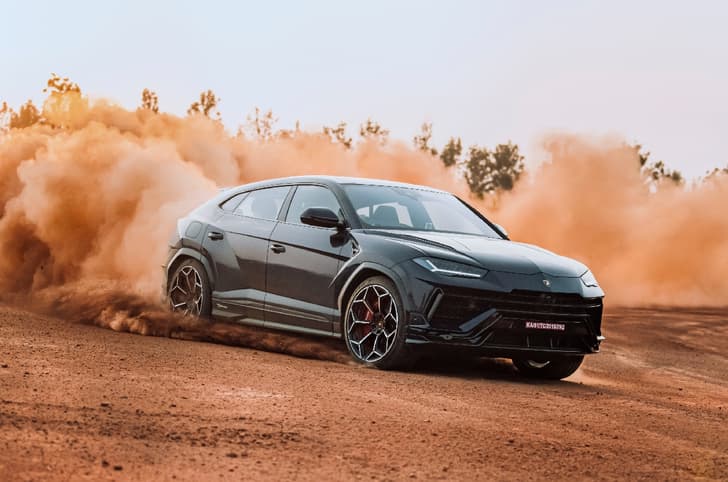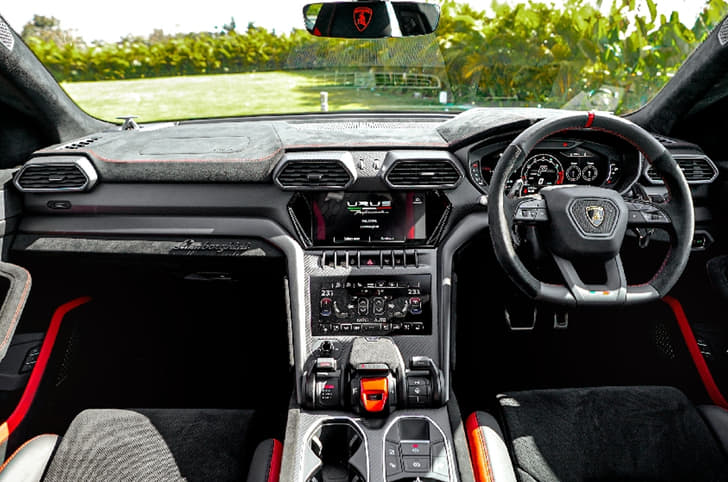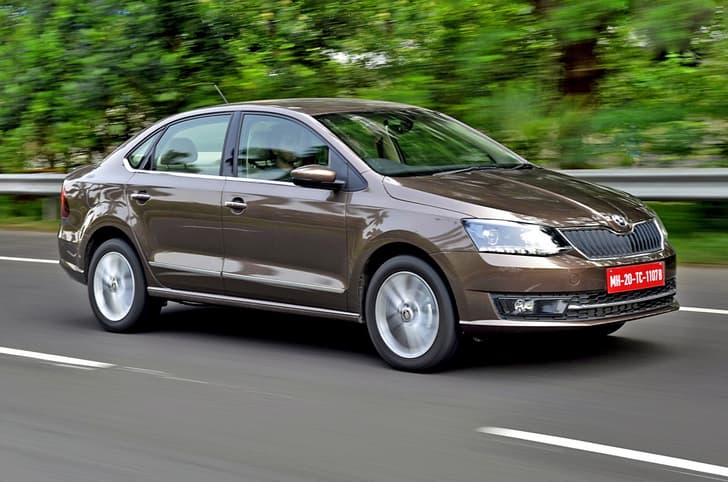What is it?
We are in Namibia to drive the reborn Defender – the most iconic Land Rover of all, that’s back in a modern avatar. The new Defender, which goes on sale this year, has big shoes to fill and an illustrious legacy to live up to. Since its origin as the Series 1 Land Rover over 70 years ago, the Defender has evoked a sense of adventure like no other 4x4. It’s been the vehicle of choice for cross-continent expeditions, military operations in conflict zones, and for anyone with a spirit to explore the most remote regions of the world.
And it doesn’t get more remote than Namibia, a relatively unknown and unvisited country with a population of a mere 2.7 million, spread over an area as big as a quarter of India. It’s the second least densely populated country in the world and has a sense of emptiness that’s surreal. You can drive for days without seeing another person, let alone another car, in this amazing African country. There are few places on earth that are better for ‘social distancing’, something over a billion people on this planet have been forced to practice today, but that’s not why Land Rover has chosen this hauntingly beautiful location. Fact is, it has a long history in Africa. Enduring images of Land Rovers crossing flooded rivers, climbing dunes in the Sahara and on safari in game reserves and immortalized in movies like Born Free and The Gods Must Be Crazy have made this vast continent the so-called ‘spiritual home of Land Rover’. It was fitting then to have the debut drive of the all-new Defender where it felt right at home.
Home for the next three days is Kaokoland, a harsh and barren region in the northwest corner of the country. Kaokoland, the outback of Namibia, is an arid and inhospitable land with barely any habitation; it’s even more barren than the rest of the country if that were actually possible. There are no roads in this region, just faint tracks through deserts and rocky trails in the hills. This is serious 4x4 country, where good ground clearance, short overhangs, and a low-ratio gearbox are all pre-requisites, but not necessarily enough to guarantee safe passage.
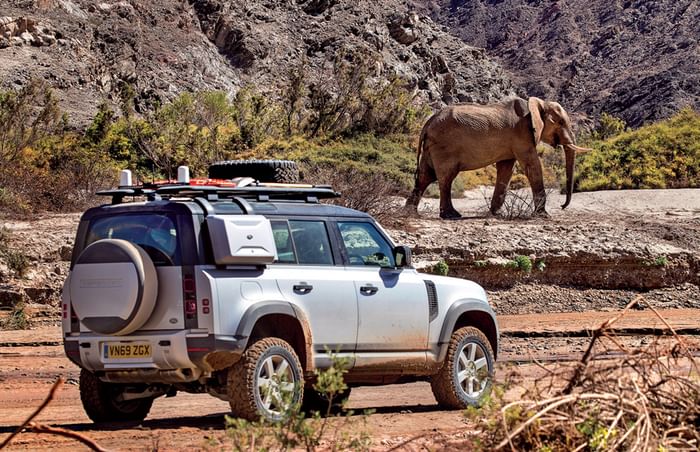
You would think it was rather brave of Land Rover to let the world’s media loose in a yet-to-be-launched product, in such brutal conditions. It’s the measure of confidence the company has in the new Defender. Besides, they also wanted to settle once for all any doubts that surrounded the capability of the all-new D7X monocoque that has replaced the body-on-frame chassis that has always underpinned the Defender and Land Rovers before it. Some Defender purists have grumbled about the move from the traditional ladder chassis, but Land Rover says the new car’s aluminium chassis is superior in every respect. And that’s what we are here to find out.
Does it look the part?
Before driving off, I take a good look at the Defender while it’s still clean and mud-free. It comes in two body styles – the 3-door 90 series, and the 5-door 110 series which has a longer wheelbase. In Namibia, it’s the Defender 110 that I’m driving.
There’s been a lot of debate about the looks of the Defender and predictably, die-hard enthusiasts find the design has strayed too far from the original, but that’s what you’d expect from classic Defender fans. Quite frankly, I just love the way the new looks. To me, it is a brilliant interpretation of the icon for the 21st century. Design chief Gerry McGovern has absolutely nailed the styling which is unmistakably Defender. The very upright, two-box silhouette, truncated rear end, side-opening tailgate with the spare mounted on it, ultra-short front and rear overhangs (critical for achieving the desired approach and departure angles) are all design elements that pay homage to the original. The traditional boxy shape remains but it’s been beautifully sculpted with tight surfacing for a clean, uncluttered modern look. Despite its tall proportions, the new Defender achieves a drag coefficient of 0.38, which is far superior to the 0.62 Cd of the previous model.
There are four engine options: two 2.0-litre diesels with 200hp and 240hp, and two petrols – a 300hp, 2.0 turbo-petrol and a 400hp, 3.0 mild-hybrid turbo-petrol. India will get only the 2.0-litre P300 petrol (300hp) that’ll be priced between Rs 69.99-86.27 lakh when it arrives in showrooms in August. A diesel will follow in a couple of months but it’s not yet clear which one. All engines are equipped with the familiar 8-speed ZF automatic transmission. There’s no manual option.
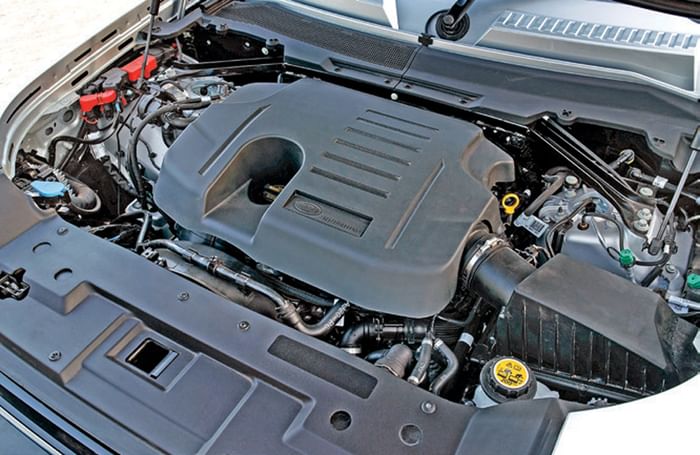
P400 mild-hybrid has a broad powerband.
For the Namibia drive, there were only two variants for us to drive: the standard 110 D240 diesel shod with 18-inch steel wheels, and the 110S P400 with 19-inch alloys. Both variants were kitted out with the optional ‘Explorer Pack’ which will add over Rs 5 lakh to your bill. This gets you a raised air intake, an external storage box, a fold-down ladder for easy access, a sturdy roof carrier, and lots of matte black plastic bits and decals to give your Defender an expedition-ready look.
How does it drive?
This test drive is more of an expedition, covering over 860km of which only 4km was on tarmac! But, ironically, those 4km were the most crucial because most Defender owners won’t stray far away from paved roads. You expect the Defender to be brilliant off-road, but how good is it on-road? That’s the question the sliver of tarmac answered. So let’s get straight to the answer 95 percent of buyers in India will want to know. For a car with a heavy-duty roof rack and a heavier spare tyre on top, the Defender no doubt feels top-heavy. Yes, there is a fair bit of body roll on grippy tarmac, and the off-road, block-pattern tyres blunt the steering response a bit. That said, the Defender feels remarkably surefooted, despite the high centre of gravity. The steering is direct and has a wonderfully reassuring and connected feel which imparts a good sense of control. The ride too is brilliant and quite settled, especially in Comfort mode. All cars come with adaptive air suspension which alters the ride height. In Access mode, the Defender drops down by 40mm for, well, easy access. In full Off-road mode, the air springs gently rise to give a maximum ground clearance of 291mm!
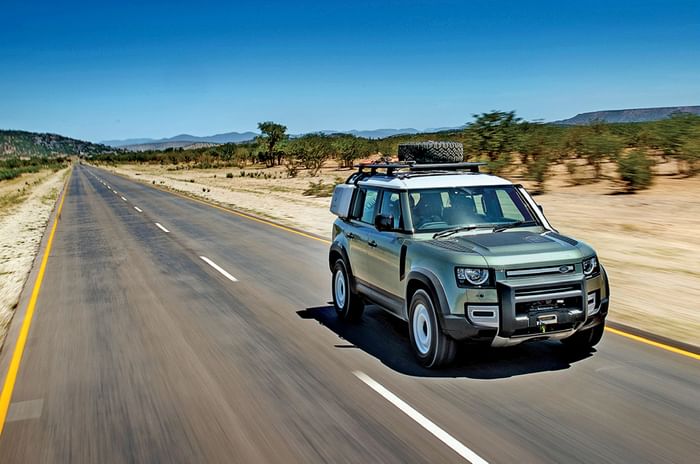
The Defender is remarkably sure-footed, despite it's high centre of gravity.
I start in the diesel D240 and the first impression is of fantastic all-round visibility from the lofty seats, aided by the upright A-pillar and large windows. But the most lasting impression is that of comfort. The Defender’s ability to soak up the punishing terrain is mindboggling, and every evening I emerged from its well-insulated cabin with not a tired bone in my body, and this included 12-hour-long drives with few breaks. I didn’t venture into the rear seat except for those few minutes when I was being chauffeured to the airstrip to fly out, and all I can say is that the high seating position, great under-thigh support, and superb legroom will be appreciated by owners. There’s place for a third row of seats, but in our car it was taken up by luggage and other paraphernalia. Speaking of storage space, the Land Rover’s cabin has it in abundance, and what I found particularly practical was the sturdy shelf above the glove box that safely held onto my GoPro, mobile phone, and suction mounts.
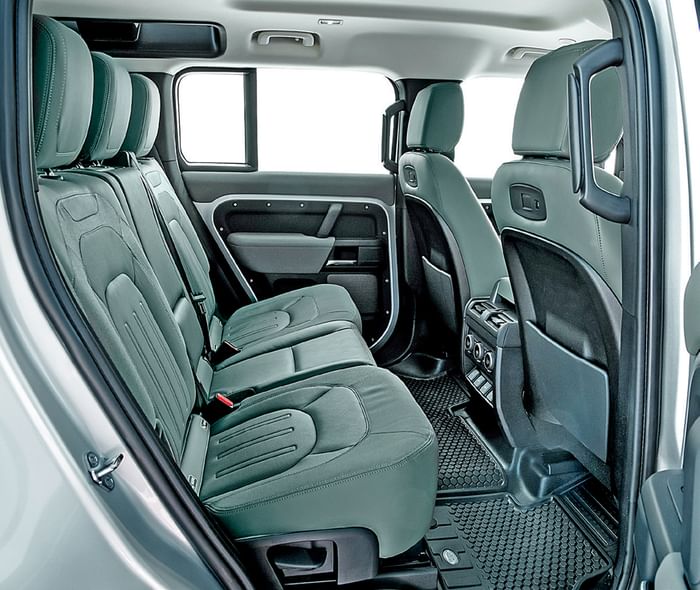
High-set rear seats spacious even for six-footers, and offer great visibility out.
Riding on 18-inch rims and high-profile tyres, I was astonished by the ease with which the D240 Defender flattened small rocks that had a nasty habit of suddenly popping out of the road. The first reaction was to wince in anticipation of a loud thwack from the suspension, but the way it soaked it all up was truly incredible. The high tyre sidewalls no doubt helped, and interestingly, out of the total 20-odd punctures picked up by the convoy of Defenders over three weeks of media drives, the taller tyres mounted on steel wheels had the fewest. Steel wheels may seem prehistoric in this day and age, but the advantage they have on this terrain is that on hard impact they bend and don’t crack like an alloy, which lessens the risk of a puncture. That’s why they are a no-extra-cost option.
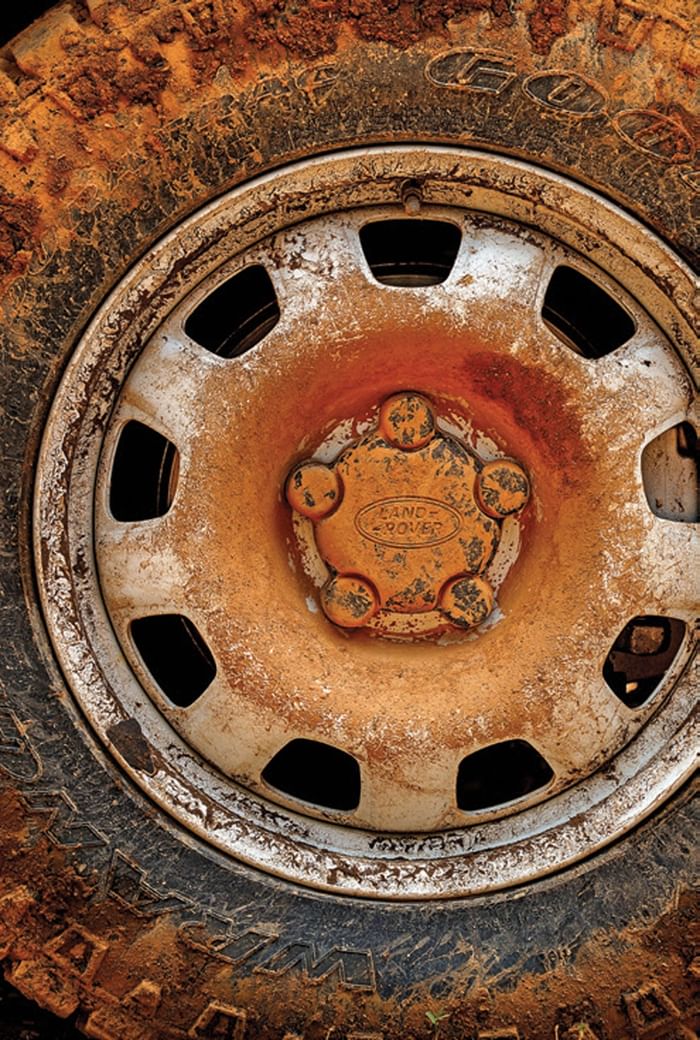
Old-school steel wheels are a no-cost option.
The 2.0-litre diesel impressed with its refinement but could do with more grunt. In the soft sand, the engine felt like it was getting bogged down, and you needed to keep the revs up to keep the momentum going. Selecting the Terrain Response System’s Sand mode with the traction control switched off seemed to work best. The Terrain Response function is now housed in Land Rover’s new Pivi Pro Infotainment system, but it still works with a 2-step operation which I don’t find as intuitive as a simple rotary dial in other cars.
JLR’s Pivi Pro infotainment system, unveiled this January at CES 2020, makes its debut in the Defender and will gradually find its way into all Jaguar and Land Rover models. It’s fast and responsive and has a high-res 10-inch screen that uses 4K graphics. Pivi Pro’s highlight is that it is the first infotainment system to have dual eSims for enhanced connectivity. The trouble was that, for most of the day, there was zero network coverage in this corner of Namibia, which made the connected features completely redundant!
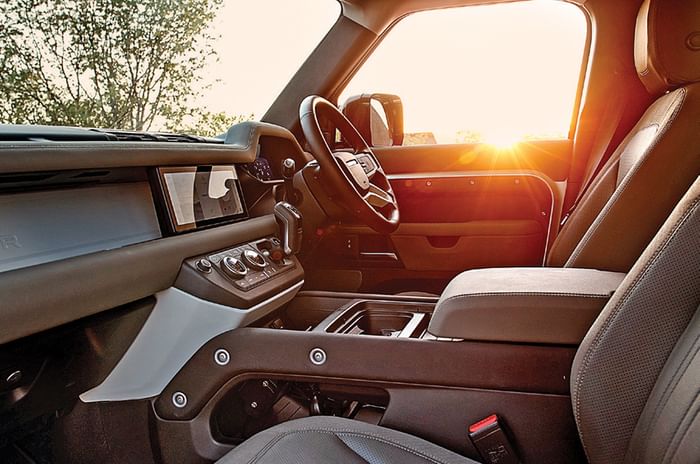
Functional and comfortable cabin comes with an abundance of storage areas.
The initial 200km also highlighted another niggle – grabby brakes. They aren’t progressive and suddenly bite in the latter half of the pedal travel. They need to be more progressive for smoother braking.
How good is it off-road?
On day two I switched to the more powerful P400 petrol for the drive up Van Zyl’s pass, one of the toughest passes in the world. Built by a Dutchman, Ben Van Zyl, this pass was made by a posse of locals using spades, axes and hammers; no earth-moving equipment was used here, and it shows. It took us 1.5 hours to cover 10km! Forget about a dirt road, in parts, the steep inclines and descents are just paths covered with massive rocks jutting out to test every millimetre of the Defender’s wheel articulation and ground clearance. It was at Van Zyl’s that I was convinced that the Defender is truly the most capable off-roader in the world. Not only did it skip from one boulder to next, but it did so with ridiculous ease. The 3.0-litre mild hybrid has a nice broad spread of torque and enough lowdown pull to yank the heavy Defender up a cliff. A tradition for those who successfully conquer Van Zyl’s is to inscribe their names on a cluster of stones at the foot of the pass, and that’s exactly what I did.
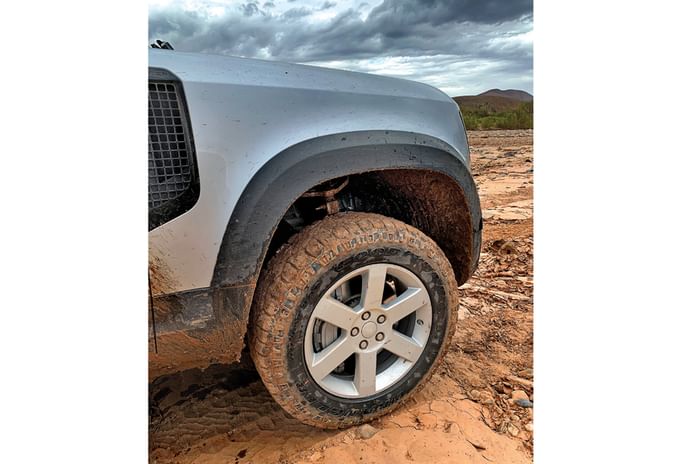
Massive ground clearance put to test.
We are back onto relatively flat terrain in the Marienfluss Valley and get a chance to stretch the Defender’s legs. It’s best to switch to manual mode to get the most out of the P400 motor which revs quite freely. It’s easy to hit speeds of 150kph on dirt tracks, and the overall stability in these conditions is pretty amazing. The Defender shimmies a bit when you suddenly hit a deep patch of sand, but the overall sense of control on loose surfaces is incredible.
On the last day we drove to Namibia’s famed Skeleton Coast, and this was the most spectacular part of the drive. Pushing through the desolate landscape we didn’t see another car for 12 hours, and, at one point, drove 20km up the Hoarusib River! The emptiness of this region, with its limitless horizons, has a haunting beauty, and the tough terrain would make even the bravest off-roader think twice before venturing into some parts. But by now, fully settled into the Defender and accustomed to its off-road prowess, the bouts of panic when crossing a river or scrambling up a slippery dune were few and far between. I knew I wouldn’t get stuck, I knew the reserve the car had, and I knew it would sail through any terrain effortlessly. The king of off-roaders is back!


















